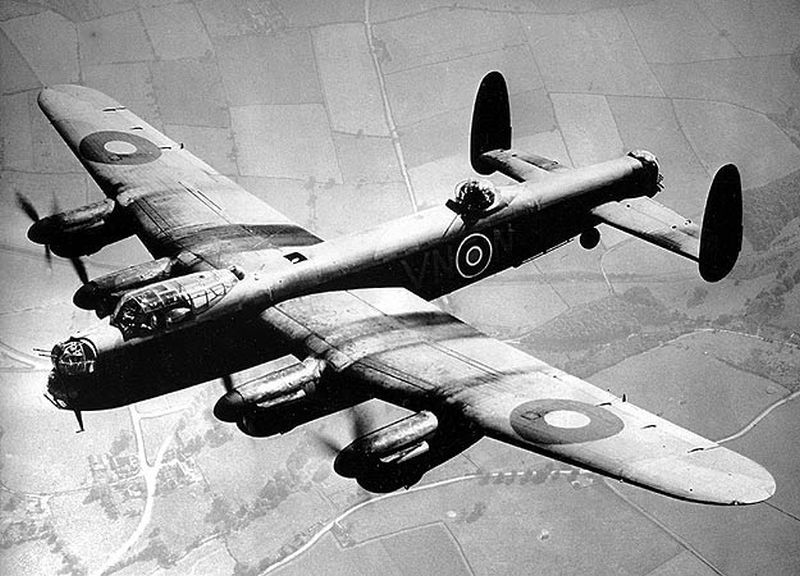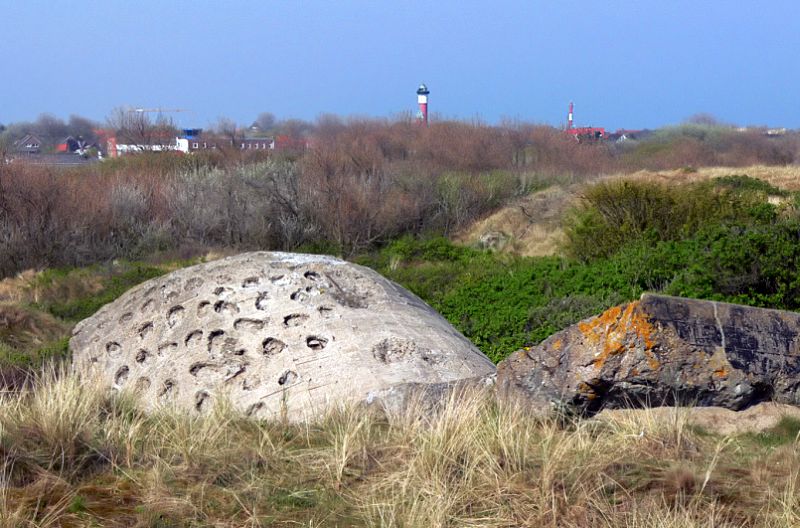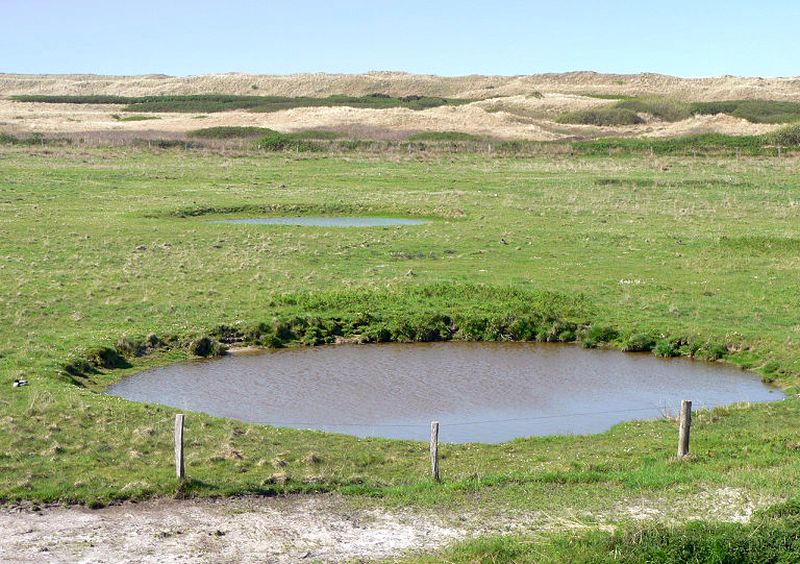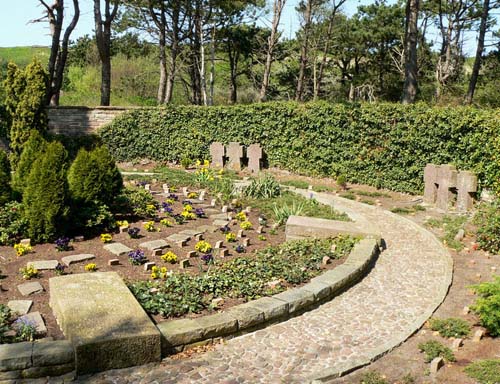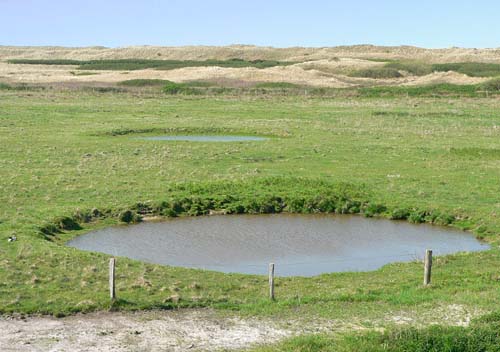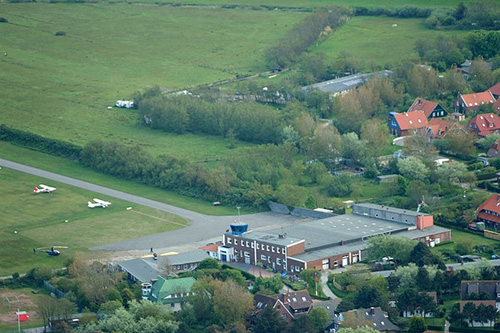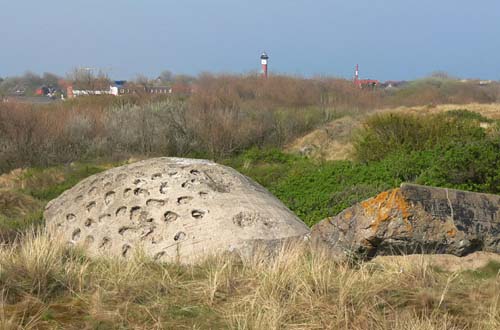Introduction
Seventy years ago, on 25 April 1945, the East Frisian island of Wangerooge was bombed by 482 bombers of the Royal Air Force. This was the last major allied air attack on German territory during World War Two. On this sunny April day not only many military and civilians were killed, but a large number of the present forced labourers as well.
The Wangerooge island lies on the debouchment of the Jade river that forms the connection between the North Sea and Wilhelmshaven and is part of the Wattenmeer, the German Wadden Sea.The island is the most eastern of the East Frisian island and belongs to the Land of Niedersachsen. It's a dune island and measures only 8,5 kms by one km. There is one village with the same name as the island. From the second half of the 19th century it became an important seaside resort for the well to do civilians from Bremen and Hamburg. To this day, tourism is an important source of income for the islanders. Wilhelmshaven has been an important naval base for one and a half century. In 1912, when the first signs of the impending war appeared on the horizon, Wangerooge, being the natural outpost in the debouchment of the Jade river that it is, received several fortifications and other defensive works. Bunkers and a coastal battery were constructed. These works, however, did not have to prove themselves during the Great War, as the anticipated British attack on Wilhelmshaven did not materialize.
During World War Two, history repeated itself. The East Frisian island had to cope with a true invasion of military and forced labourers. These were ,for the main part, soldiers of the Kriegsmarine and prisoners who worked for the Organisation Todt. The navy personnel manned the air defence posts and coastal batteries and ,later in the war, the various radar installations. The forced labourers were deployed for building even more military infrastructure. As the allied pressure on Germany increased, German High Command again feared an invasion of Northern Germany and the conquest of Wilhelmshaven. The Germans therefore took measures to deter this new front, which they expected to come about in the German Bight. To this end the defensive measures at Wangerooge were immensely stepped up. After the successful landing in Normandy in June,1944, reinforcing Wangerooge was declared a top priority. The number of military personnel on the East Frisian island increased drastically and large numbers of forced labourers and other prisoners were transported to the island by ship. The prisoners were deployed as forced labourers in the construction of air defence and coastal battery foundations, bunkers, air raid shelters and other military fortifications.
Definitielijst
- invasion
- Armed incursion.
- Kriegsmarine
- Germa navy. Part of the Wehrmacht next to Heer and Luftwaffe.
- radar
- English abbreviation meaning: Radio Detection And Ranging. System to detect the presence, distance, speed and direction of an object, such as ships and airplanes, using electromagnetic waves.
- raid
- Fast military raid in enemy territory
Images
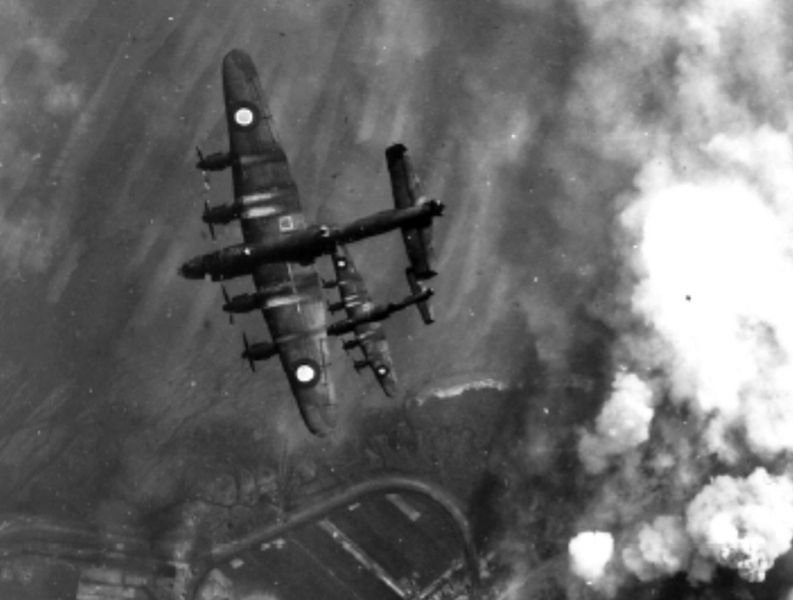 Avro Lancaster bombers over Wangerooge, 25 April 1945. Source: National Archives.
Avro Lancaster bombers over Wangerooge, 25 April 1945. Source: National Archives.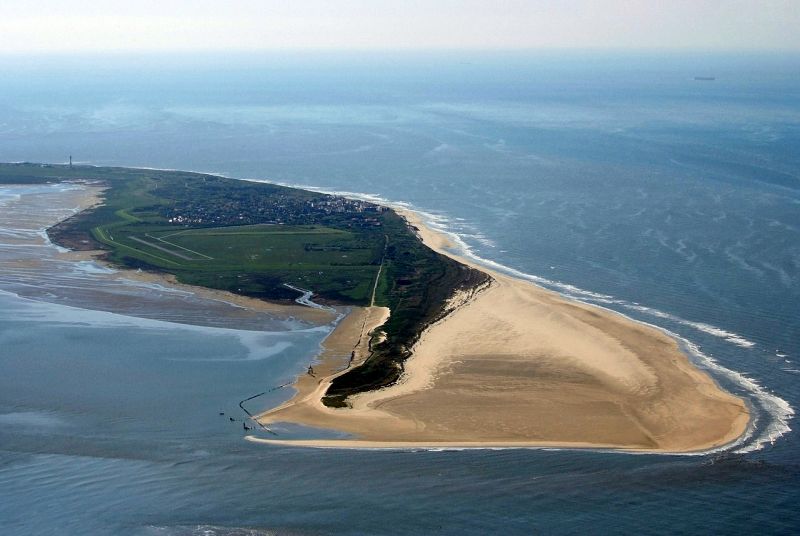 The modern Island of Wangerooge. Source: Wikipedia.
The modern Island of Wangerooge. Source: Wikipedia.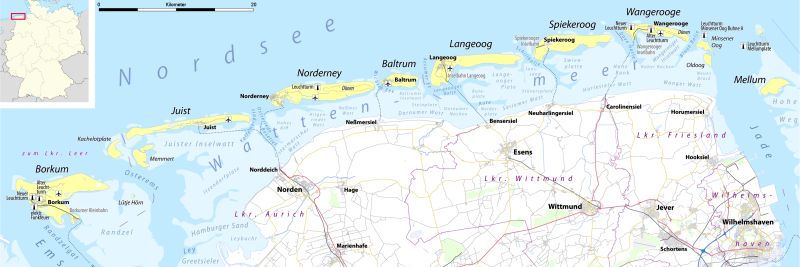 Map of the East Frisian Islands Source: Wikimedia.
Map of the East Frisian Islands Source: Wikimedia.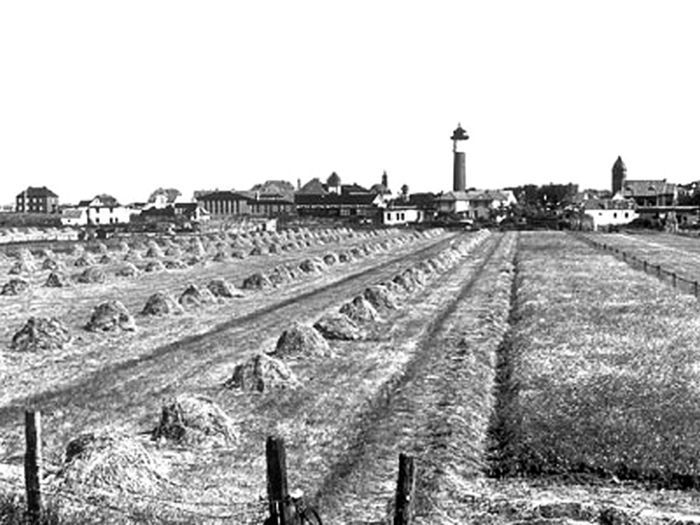 Wangerooge in 1938. Source: Kirche am Meer Wangerooge.
Wangerooge in 1938. Source: Kirche am Meer Wangerooge.The forced labourers
The prisoners were mainly Poles, Russians, French and Dutch. Besides, there were several Belgians and a handful of French speaking Moroccans. Each nationality had its own status and was treated accordingly. The Poles had the lowest status in the German opinion. The Russians were in general former POW's that had chosen to join the Germans as volunteer in order to avoid starving in the German POW camps. Formally they were volunteers. The French and Moroccans were official POW's and were treated according to international protocol. They had practically unlimited freedom of movement and were quartered on top floors of houses and municipal buildings of the only village on the island.
Of the 350 foreigners that were employed on the island, 110 had the Belgian or Dutch nationality. Strictly considered they were not prisoners, but they were certainly not volunteers either. The Dutch were mainly men from East Groningen who were forced to work for the Germans.One of them was Jans Hut. He remembers the following on this time. "As usual we were busy with our reclamation work for the Heidemij when suddenly Germans appeared at work who confiscated the papers of our boss. We were ordered to report the next day in Appingedam for work in Delfzijl. When we arrived there the situation seemed not good to me, for there were people from the Organisation Todt. These were Germans who were responsible for construction work. We did not go to Delfzijl, but travelled by bus through Nieuweschans to the coastal place Norddeich and from there to the Norderney island. We had to pour concrete there.We were there for a fair amount of time until we were collected by small coasters to the harbour of Wangerooge.
Formally, the Dutch were not prisoners, but the living- and working standards were bad.Mister Hut: "In Wangerooge we also came in sad conditions. We were quartered in barracks that had contained Poles. The place was lice ridden. From time to time we went ashore, to a factory near Bremen where we were deloused. There the clothing was also cleaned. It was this greyish soldier clothing. One received it back so steaming hot that you could not hold it on your body. Then we returned to Wangerooge." From the end of 1943 onwards a number of Dutch were brought in from the concentration camp of Amersfoort.These were mainly men who had tried to evade the Arbeitseinsatz, the obligatory working in Germany. Some had refused to show up at the call to be registered. Others failed to report back to duty after their vacation. The men from East Groningen still had some amount of liberty at Wangerooge, but those from the KZ Amersfoort were treated like the Poles and had the lowest status.
The circumstances under which forced labourers had to work were already bad at the beginning of the war. During the war, they had only deteriorated .There was a chronic shortage of clothing and shoes. Especially food was in short supply. During the final years there was only bread and diluted pea and cabbage soup.On this scant menu the men had to work from eight in the morning till five in the afternoon. The work was physically demanding. It consisted mainly of digging and toting work, braiding steel and pouring concrete. The Groninger Daan Smit told about his work: "The Baustellen (building locations) were dug by hand. We moved tons of sand. In one Baustelle you were with 50 others. Sometimes you stood in each other's way when you wanted to depose of a scoop of sand. When a pit was ready, a steel mat was put on the bottom and then you began to pour concrete. The building materials were brought to the location by narrow-gauge from the harbour."
Mister Bob Veenstra from Groningen told about the bad working circumstances at Wangerooge: "We had a bad time there. Heavy and unusual work from the early morning to late in the evening. Either you worked in the gravel, the sand or the cement. Especially the cement was bad, the more so when there was even the slightest bit of wind.That stuff flew around everywhere. After a few days every orifice was filled by it and your eyes were damaged. One time we asked the foreman if we could be relieved, but they would have none of it.But we simply could not go on.Then soldiers came to us with their rifles at the ready. You were in front of the firing squad as it were. But even if they had shot me, I would not have cared. I was literally death-tired.Then an officer came along who wanted to see why the group had stopped working. He considered the situation and disappeared quickly. A bit later we were relieved and we went from the cement to the sand. In hindsight you realize you could have been shot for the same trouble."
Definitielijst
- Arbeitseinsatz
- “Labour deployment”. Forced deployment in the German industry. Approximately 11 million European citizens were rounded up and deployed into forced labour in the Third Reich. Not to be confused with the Arbeidsdienst or labour service, an organisation for national-socialist education for Dutch youngsters.
- concentration camp
- Closed camp where people are being held captive that are considered to be anti- social, enemies of the state, criminal or unwanted individuals. These groups mostly do not get a fair trial or are condemned to doing time in a camp.
- POW
- Prisoner of War.
Images
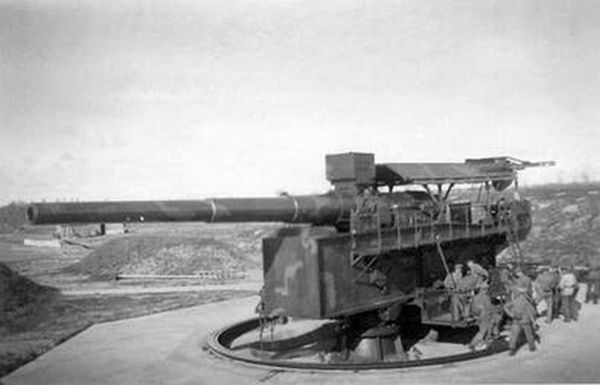 A 30,5cm coastal battery on Wangerooge. Source: Wikipedia.
A 30,5cm coastal battery on Wangerooge. Source: Wikipedia.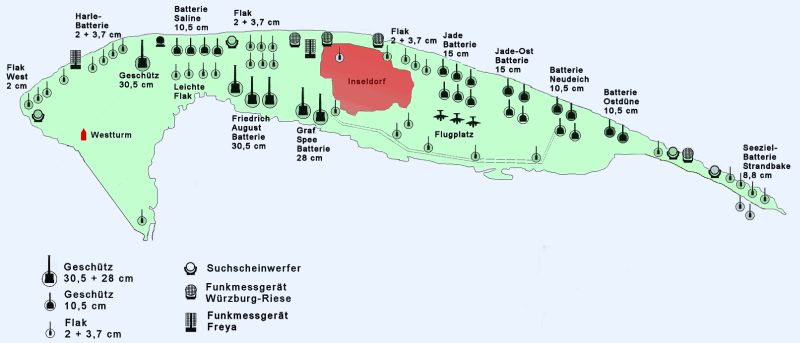 The fortifications on Wangerooge which were built by the forced labourers. Source: Wikipedia.
The fortifications on Wangerooge which were built by the forced labourers. Source: Wikipedia. Everything on Wangerooge, including the building materials and the forced labourers themselves, were brought in via the harbour Westanleger Source: Insel Rundgang.
Everything on Wangerooge, including the building materials and the forced labourers themselves, were brought in via the harbour Westanleger Source: Insel Rundgang.Before the air raid
The western allies on 1 April,1945, planned to attack several of the fortified Frisian islands together with the conquering of the harbours of Emden and Wilhelmshaven. A repetition of the problems in Zeeland was feared. In 1944, after Antwerp was conquered, the harbour was out of use for months because the Germans still controlled large parts of the water way towards Antwerp.Marshall Bernard Montgomery, commanding officer of the 21st Army Group, planned the following: Canadian troops were to advance along the coast after the conquest of Bremen through Emden and Wilhelmshaven. They would also prepare the conquest of the islands. Due to her strategic situation, the island of Wangerooge was given priority, followed by Borkum, Norderney and Juist.The operation was to be planned and executed together with the Royal Navy.After that allied reconnaissance planes photographed the islands systematically in order to assess the strength of the German defences, Wangerooge turned out to have been transformed into a formidable stronghold. This was not only because of the batteries and military building that the Germans already had constructed but also because the Germans had positioned many fake batteries.These observations led the Canadians to refrain from a landing assault because heavy losses were feared. In this stage of the war a risk like this would not to be taken.A destructive air raid was to eliminate the fortress of Wangerooge. On second thought Monty agreed with this plan.
On 25 April 1945 around 14:25 hour, 466 four engined Handley Page Halifax and Avro Lancaster bombers and sixteen two engined De Havilland Mosquito pathfinders took off from 25 airbases in southeast England for the last great air attack of the RAF on a target in Germany. Of the 482 bombers, 266 were manned by the Royal Air Force (RAF), 194 by the Royal Canadian Air Force (RCAF) and 18 by the Forces Aériennes Françaises Libres (FAFL, the air force of the free French). In total there were approximately 3,300 crew members on board of the allied airplanes and the aircraft carried 2,176 tonnes of bombs with them.
In the afternoon at five o'clock, the forced labourers at Wangerooge were marched from their work location to their barracks. Several German military reconnaissance posts had reported that a formation of around 500 airplanes was at large on 350 kms from Wangerooge. On the island itself these messages were received by the Germans with resignation. They had become accustomed to large numbers of allied bombers that dropped their deadly cargo on some of the final square kilometers that still remained in German hands. The strongest radar on Wangerooge, the Wassermann with a range of 400 kilometres, had by that time long noticed the bombers. The officer in charge had seen a change in course and drew the conclusion that the bombers might be heading to Wangerooge. He reported this to the island commander, but for unknown reasons no reaction was given. Half an hour later the smaller Würzburg and Freya radars saw the incoming air fleet. Again the news was passed and again no reaction developed. The civilians, military and forced labourers were totally unaware of the disaster that came towards them.
Definitielijst
- Freya
- German long range radar named after a Germanic goddess. Was used as an early warning system for incoming bombers. Could detect aircraft from take-off.
- radar
- English abbreviation meaning: Radio Detection And Ranging. System to detect the presence, distance, speed and direction of an object, such as ships and airplanes, using electromagnetic waves.
- RAF
- Royal Air Force. British air force
- raid
- Fast military raid in enemy territory
- Würzburg
- German short range radar. Was used to guide searchlights, FLAK and guiding German night fighters.
Images
 A Lancaster crew preparing. Source: National Archives.
A Lancaster crew preparing. Source: National Archives.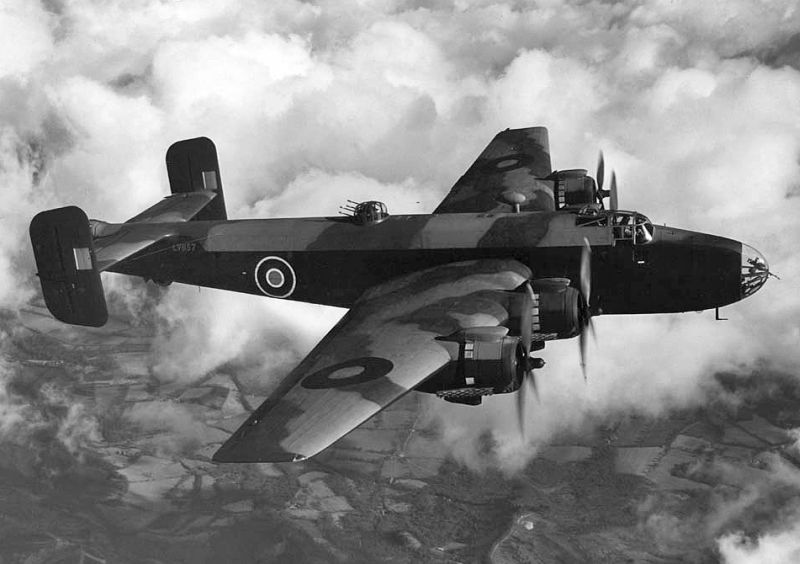 A Handley Page Halifax Mk 3 bomber. Source: Wikipedia.
A Handley Page Halifax Mk 3 bomber. Source: Wikipedia.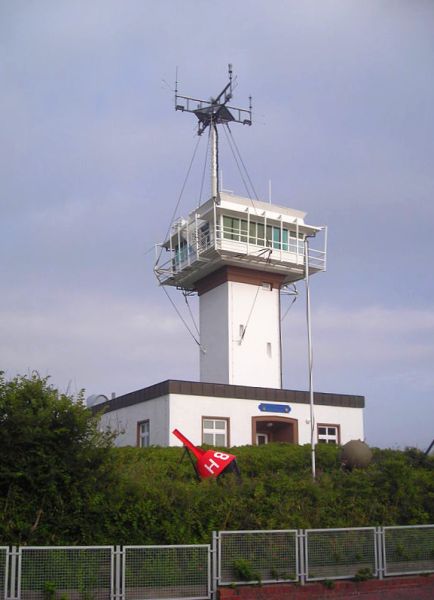 The Signalstelle on Wangerooge on which the Wassermann radar was mounted. Source: Wikipedia.
The Signalstelle on Wangerooge on which the Wassermann radar was mounted. Source: Wikipedia.The air raid
On 16:47 hours, finally an alarm was sounded at Wangerooge by the central communication post on the island that had received messages from transmitting posts on shore. This alarm was directed to the civilian population, that immediately ran for the air raid shelters. A number of them ,however, was too late to find refuge. At 16:59 hours, the pathfinding Mosquitoes dropped their coloured markers for the incoming bombers.Less than a minute later the planes came under anti aircraft fire, although most servicemen had run for cover in the bunkers. A large number of them was also too late. Only the moment that the first bombs hit the island did the first sirens sound on the island.The howling sound of the sirens mixed with the ever increasing roar of the bombers. Seconds later the first exploding bombs blotted out the other sounds including ringing field telephones and the shouting voices of military, civilians and forced labourers.
The first wave of attack was directed against the east side of the island. Immediately following this group came the Mosquitoes that dropped the markers for the second wave over targets on the western part of the island. The allied bombers of the first two waves were still able to drop their payloads well directed.The bombardiers of the following waves were blinded by the sand and smoke of the previous waves, sometimes kilometers high. With these later waves the fate of the village was sealed. The whole attack lasted only 15 minutes but in this short time over 6,000 bombs were dropped.
The Dutch forced labourer Daan Smit on the bombardment: "When the bombing began we were outside of the village. It was the end of our work day and under escort of a soldier we marched back to our barracks. All of a sudden there were these planes. With the first attack they dropped flares with which they marked the targets for the heavy bombers that followed suit. These bombers dropped some amazing stuff, it was unbelieveable. We ran with some men into a bunker but this turned out to be a bunker for ammunition. All crates with death's heads on them. So we ran outside but there were the bombs you reckon. It was pure hell, all the sand and smoke and I thought I was suffocating. I had pressed myself against the dune and it only took a short while for me to be covered by sand.German soldiers dug me out with their hands. I was plain lucky that they were near and that they heard me for I was also covered in branches. I remember that one of our lads lay further on. He could not say a word. There were more like them, it was a state of shock. One of our boys had lost both of his legs.Remarkably, we were all anti English all of a sudden, although they were our liberators. But I guess that's the way a human being reacts to this kind of stress."
The bombing had turned civilian life and the military organisation at Wangerooge upside down and had turned everything into chaos. The village was largely destroyed, bunkers had been obliterated by direct hits and the prisoner's barracks, in which most of the Groningen men had lived, had disappered from the face of the earth. Losses on all sides were high. Soldiers, civilians and forced labourerers had all been through the same anguish. Everywhere on the island people helped each other.Daan Smit: "The organisation was totally lost, the barracks were lost as well by the way. We went to the village to help. We wanted to help everywhere. The village was flattened, fires were everywhere and people were busy all over the place.It was everyone for himself, but you would help when you ran into trouble. It was also a magnificent occasion to steal bread, for we were starving continuously."
Definitielijst
- raid
- Fast military raid in enemy territory
Images
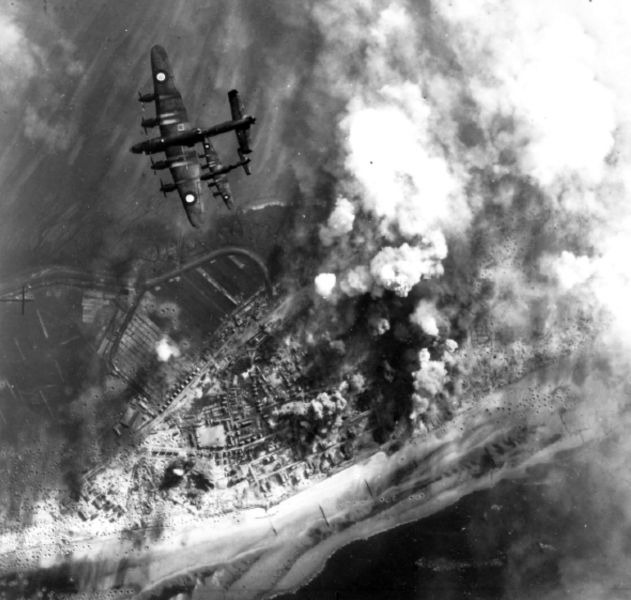 The bombing of Wangerooge, 25 April 1945. Source: Juno Beach.
The bombing of Wangerooge, 25 April 1945. Source: Juno Beach.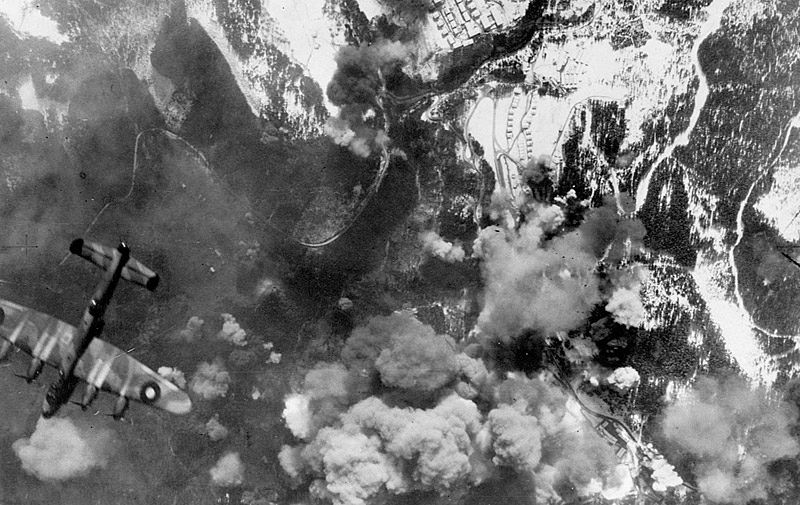 Another shot of the air raid on Wangerooge. Source: National Archives.
Another shot of the air raid on Wangerooge. Source: National Archives.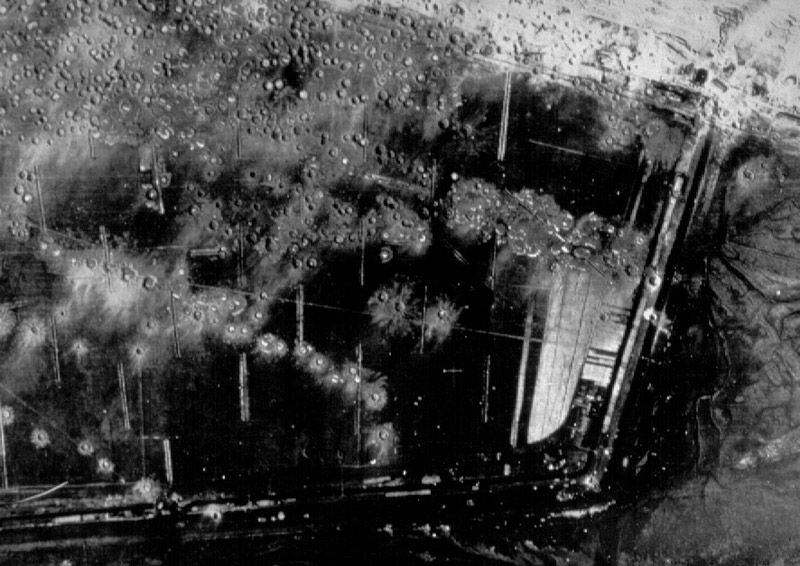 The carpet bombing of Wangerooge. Source: Mellumrat.
The carpet bombing of Wangerooge. Source: Mellumrat.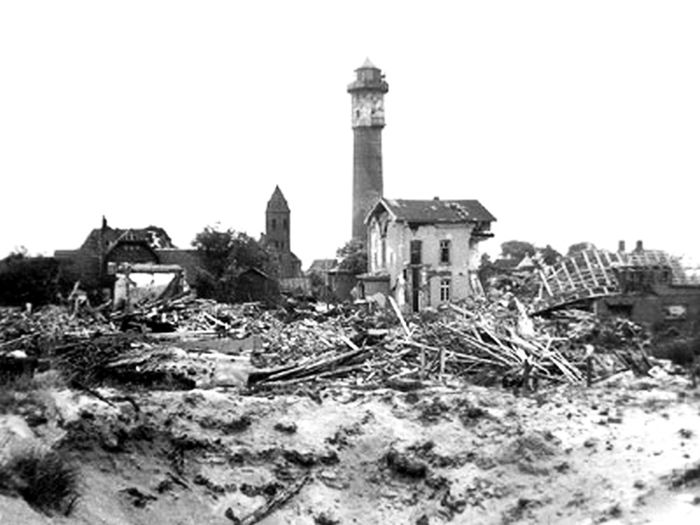 Destruction on Wangerooge after the air raid. Source: Insel Rundgang.
Destruction on Wangerooge after the air raid. Source: Insel Rundgang.Consequences of the air raid
The air raid on Wangerooge cost the lives of 131 military, six so called Marinehelferinnen (German auxiliary female navy personnel) and 21 villagers. The forced labourers had 121 dead including 48 Dutch.A number of 120 injured was brought to the main land and was hospitalized in Wittmund. The island itself had turned into a moonscape through the countless bomb craters. The telephone, running water and the sewers were destroyed.
Still the stricken island did not surrender after the air raid.The military tried to bring some order in the chaos. Some anti aircraft positions and coastal batteries that had not been hit were manned and the distribution of clothing and food under the prisoners was started again. The prisoners could move freely and the military did not bother to get them to work again. The last days of the war the island remained out of action and on 5 May, the garrison surrendered together with the other German troops in northwestern Europe.
The allies had lost six bombers during the bombing of Wangerooge because they flew into each other. One bomber was shot down by the German air defences. 49 Allied crewmen perished with these seven bombers.The surviving Dutch wanted to go home as soon as possible. Some of them walked to the harbour where four Dutch vessels lay moored. The captains were willing to bring them home to Delfzijl. When the Canadians arrived on 12 May at Wangerooge most of the Dutch had already left for days. One of the ships that transported refugees, the inland transporter Joanna, had struck a mine on 9 May with all hands lost in sight of the harbour. The tragedy with the Joanna took 39 lives on the Eems in peace time.
Definitielijst
- mine
- An object filled with explosives, equipped with detonator which is activated by either remote control or by colliding with the targeted object. Mines are intended to destroy of damage vehicles, aircrafts or vessels, or to injure, kill or otherwise putting staff out of action. It is also possible to deny enemy access of a specific area by laying mines.
- raid
- Fast military raid in enemy territory
Images
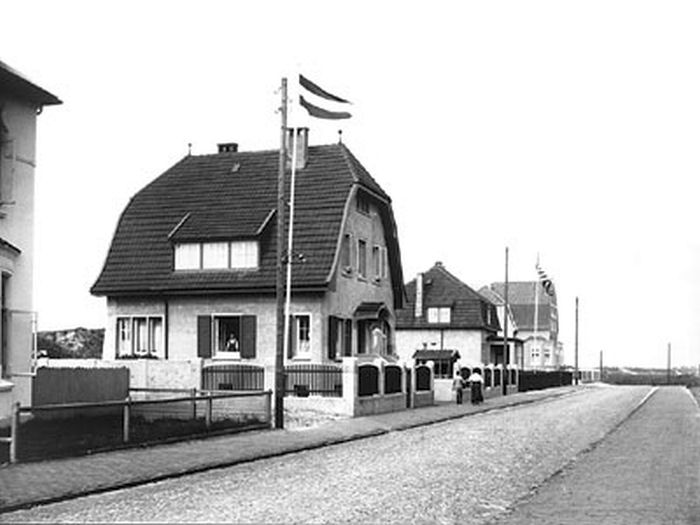 The House at Steingarten in 1944. Source: Insel Rundgang.
The House at Steingarten in 1944. Source: Insel Rundgang.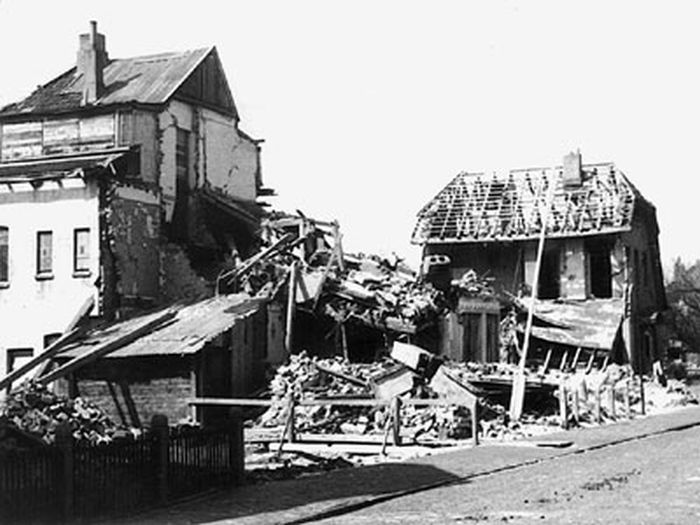 The House at Steingarten after the air raid. Source: Insel Rundgang.
The House at Steingarten after the air raid. Source: Insel Rundgang.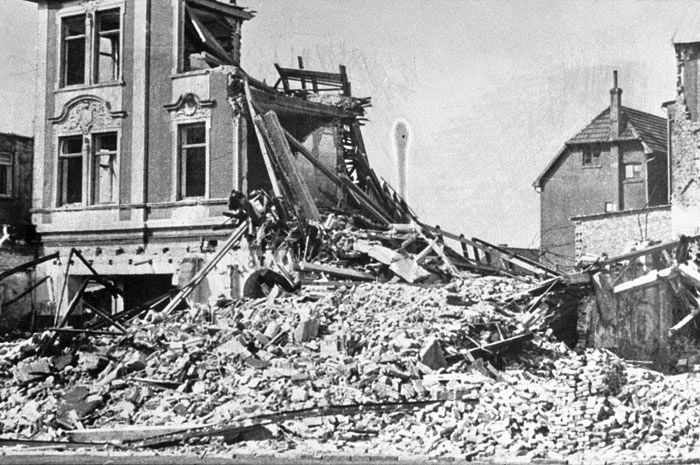 Remains of Hotel Hanken. Source: Insel Rundgang.
Remains of Hotel Hanken. Source: Insel Rundgang.Conclusion
Although the allied air attack intended to destroy the military installations at Wangerooge these remained largely intact. The main blows struck the village and the forced labourer's camps. This was mainly due to the fact that the RAF had not taken into account the effect of the columns of smoke and sand that were thrown up by the first bombing. In this way the bombardiers of the following waves were not able to aim well and dropped their pay loads into the fray. Militarily spoken the air raid was a failure and in hindsight was possibly even superfluous.
One of the bunkers, a 20 person command bunker that received a hit during the first wave, was sealed by masoning and declared a war grave. The Canadians that occupied the island on 20 May, blew up the remaining bunkers in June, 1945. In 1951, the Volksbund Deutsche Kriegsgräberfürsorge(VDK) installed an honorary graveyard for 238 victims of the bombardment. Until the seventies from last century numerous remains of bunkers and bomb craters could be found. Most remains of bunkers nowadays are covered by the sand and are overgrown by vegetation.Some bomb craters are filled with rain- and groundwater and are home to ecologically valuable miniature biotopes.
Definitielijst
- RAF
- Royal Air Force. British air force
- raid
- Fast military raid in enemy territory
Images
Information
- Article by:
- Peter Kimenai
- Translated by:
- Peter ter Haar
- Published on:
- 19-05-2015
- Last edit on:
- 05-05-2017
- Feedback?
- Send it!
